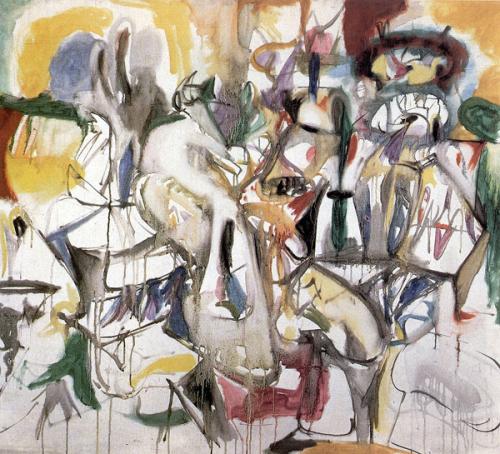Description
The work "How my mother's embroidery of Arshile Gorky, created in 1944, embodies a confluence of emotions and memories that are deployed through a completely pictorial language. Gorky, a central figure of surrealism and abstract expressionism, uses this painting to weave an intimate connection between his own life and his inheritance, reflecting both the influence of his mother and the impact of his homeland, Armenia.
From a compositional perspective, the work is presented as an amalgam of organic forms and a rich symbology. The embroidery apron, which stands as the central symbol of the piece, is presented in a stylized and vibrant manner, as if he became his own life. Gorky uses the use of a fluid and dynamic line, which draws not only the image of the apron, but also the atmosphere full of nostalgia and affection. Around it, abstract forms and textural details that avoid literality are displayed, suggesting a more emotional than objective interpretation. That artistic choice invites the viewer to remember not only the object of everyday life, but also the moments and relationships that surrounded him.
The use of color in this work is revealing and deeply significant. Gatchy selects a palette that challenges conventional representation. Terracotta and green tones, next to a soft blue nuance, create an atmosphere that ranges between the warmth of the home and the melancholy of memory. This duality occurs in the way in which colors vibrate and intertwine, cultivating an almost palpable sensation of intimacy and vulnerability. The emotional burden of colors turns apron into an object loaded with meaning, transforming it into an emblem of motherhood and care, as well as loss and exile, recurring issues in Gorky's life.
Although there are no explicit human figures in the work, you can feel an incorporeal presence, that of the mother. The way in which the apron is deployed and transforms into the composition suggests the collective memory of past generations, as well as the lasting influence of the maternal. Gorky, who was forced to leave his home due to political and personal circumstances, materializes his yearning for his mother and his land in this intimate object, establishing a visual dialogue between the personal and the universal.
The historical context in which Gorky paints this work is also crucial. In the 1940s, the artist faced the diaspora and the crises of modern art, as well as his own internal struggles. "How my mother's embroidery for my mother develops" then becomes a kind of emotional refuge, a reminder of his inheritance and an attempt to reconcile his present with his past. The work is within a broader frame of modern art, where the autobiographical one mixes with the abstract, a trend that Gorky knew how to cultivate with mastery.
In short, Gorky's painting is a magnetic piece that emanates a deep emotional resonance. "How my mother's embroidery apron develops in my life" is more than a representation of a daily object; It is a trip through memory, love and loss. As the viewer immerses himself in the work, he will be invited to reflect on the echoes of his own life, turning the aesthetic experience into a personal introspection. Arshile Gorky, through this work, not only captures the essence of maternal love, but also offers a window towards its complex inner world, making this piece an unforgettable masterpiece in the canon of modern art.
KUADROS ©, a famous paint on your wall.
Hand-made oil painting reproductions, with the quality of professional artists and the distinctive seal of KUADROS ©.
Art reproduction service with satisfaction guarantee. If you are not completely satisfied with the replica of your painting, we refund your money 100%.

